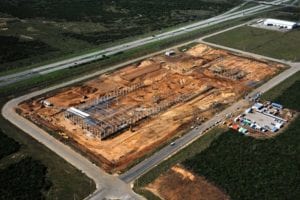Pictured: This site in the Coega Industrial Development Zone (IDZ) will be utilised in a unique experiment for naturally rehabilitating non-industrial sites in the IDZ
The Coega Development Corporation (CDC), Uhambiso and WBHO Construction are launching a pioneering environmental experiment as a baseline study in the Industrial Development Zone (IDZ). The first ever Coega IDZ “ecosynthesis experiment” project started this month on a recently downgraded piece of virgin land adjacent to a site in Zone 2 of the Coega IDZ earmarked for Chinese car and truck manufacturer, First Automotive Works’ (FAW) new plant, which WBHO is currently constructing. The environmental project will run for 12 months, with all costs covered by the Uhambiso/WBHO joint venture (JV). “The area, roughly 500 m2, will undergo a natural restoration process and essentially we are allowing for the practice of ecosynthesis principles on this land,” says Johann Brink, CDC safety, health and environmental project manager. Ecosynthesis is a term used to describe the use of naturally introduced species to fill niches in a disrupted environment, with the aim of increasing the speed of natural ecological restoration. This method decreases the amount of physical damage to a disrupted and degraded landscape. Ecosynthesis is also the process of taking topsoil containing the natural seed bank of endemic plant species of the specific area and spreading it over a degraded area – then allowing “mother nature” to take its course. This deviates from the norm of hydro-seeding, or direct human intervention in the rehabilitation process. “Essentially the hydro-seeding is replaced by the natural seed bank contained in the topsoil within that specific area. Thus, the ‘import’ of topsoil from outside the IDZ is not an option as we want to avoid introducing species not natural to that specific environment and landscape.” “We will measure the rainfall over a 12 month period as well as germination of the natural seed bank – and then the identification of seedlings that have come up. Basically we want to see what mother nature gets up to so we can measure how to manage environmental support in an industrial zone and analyse how, without human intervention, the ecosystem will regenerate itself,” added Brink.Traditionally industrial areas, and those under construction, are not considered suitable for rehabilitation, for a range of reasons, including cost. However, legislative changes over the past 20 years have paved the way for better environmental rehabilitation methods.
“The implication of not rehabilitating around a construction footprint is severely detrimental to the natural environment and ecosystems affecting both visual impact and plant and animal species, which can possibly be lost,” says Arnie van Jaarsveld, site manager for the WBHO Construction of FAW’s site. “We are highly interested in this baseline study as it could form the basis of future WBHO engagements with the environment on construction projects.” Environmental authorisation for listed activities usually has standard conditions in terms of prescribing rehabilitation in or around the construction footprint. The more recent rehabilitation standards in the construction related environmental degradation entails hydro-seeding which consists of either a summer or a winter seed mix and adds costs to the construction project. Brink says ecosynthesis– applied in two areas in the IDZ – has been successful at Coegabut was never properly monitored, measured and recorded for future reference and application. Thus far these two areas, in Zone 10 (a construction footprint in the sand dune area)and Zone 5 (a historical degraded area of “borrow pits”) have both yielded positive but untested results. “Both these areas underwent ecosynthesis rehabilitation seven and four years ago respectively which proves that the natural seed bank to that specific area is more resistant to drought and has a low mortality rate despite the lack of rain,” said Brink. The “experiment“ aims to prove amongst other things that with very little human intervention ecosystems in or around degraded areas can return to their original natural vegetated state and thereby heal the holistic ecosystem from being dysfunctional to functional. “The focus of the ecosynthesis experiment is not on cost saving but rather natural environmental restoration in a holistic manner, restoring the intrinsic value which originally existed in the ecosystem landscape prior to degradation,” adds Brink. As with all experiments, there will be a control in place – in the form of a piece of land where human intervention takes place to rehabilitate the land. On-going updates and results will be released by the CDC over the year-long period.







